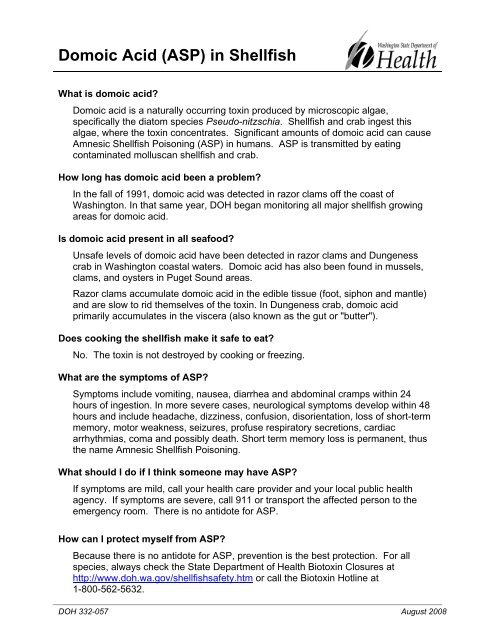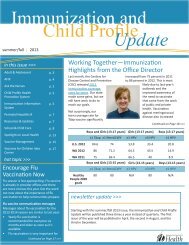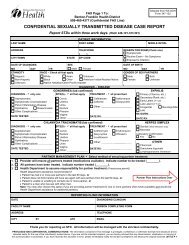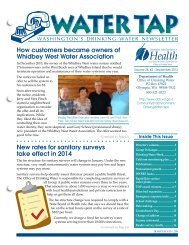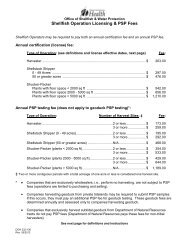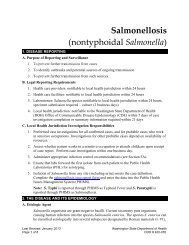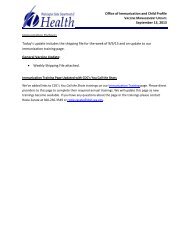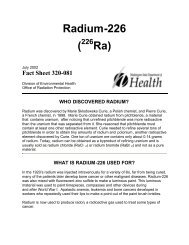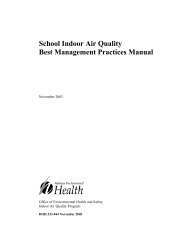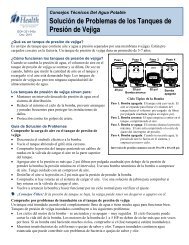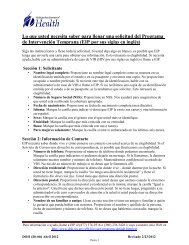Domoic Acid (ASP) - Washington State Department of Health
Domoic Acid (ASP) - Washington State Department of Health
Domoic Acid (ASP) - Washington State Department of Health
You also want an ePaper? Increase the reach of your titles
YUMPU automatically turns print PDFs into web optimized ePapers that Google loves.
<strong>Domoic</strong> <strong>Acid</strong> (<strong>ASP</strong>) in Shellfish<br />
What is domoic acid?<br />
<strong>Domoic</strong> acid is a naturally occurring toxin produced by microscopic algae,<br />
specifically the diatom species Pseudo-nitzschia. Shellfish and crab ingest this<br />
algae, where the toxin concentrates. Significant amounts <strong>of</strong> domoic acid can cause<br />
Amnesic Shellfish Poisoning (<strong>ASP</strong>) in humans. <strong>ASP</strong> is transmitted by eating<br />
contaminated molluscan shellfish and crab.<br />
How long has domoic acid been a problem?<br />
In the fall <strong>of</strong> 1991, domoic acid was detected in razor clams <strong>of</strong>f the coast <strong>of</strong><br />
<strong>Washington</strong>. In that same year, DOH began monitoring all major shellfish growing<br />
areas for domoic acid.<br />
Is domoic acid present in all seafood?<br />
Unsafe levels <strong>of</strong> domoic acid have been detected in razor clams and Dungeness<br />
crab in <strong>Washington</strong> coastal waters. <strong>Domoic</strong> acid has also been found in mussels,<br />
clams, and oysters in Puget Sound areas.<br />
Razor clams accumulate domoic acid in the edible tissue (foot, siphon and mantle)<br />
and are slow to rid themselves <strong>of</strong> the toxin. In Dungeness crab, domoic acid<br />
primarily accumulates in the viscera (also known as the gut or "butter").<br />
Does cooking the shellfish make it safe to eat?<br />
No. The toxin is not destroyed by cooking or freezing.<br />
What are the symptoms <strong>of</strong> <strong>ASP</strong>?<br />
Symptoms include vomiting, nausea, diarrhea and abdominal cramps within 24<br />
hours <strong>of</strong> ingestion. In more severe cases, neurological symptoms develop within 48<br />
hours and include headache, dizziness, confusion, disorientation, loss <strong>of</strong> short-term<br />
memory, motor weakness, seizures, pr<strong>of</strong>use respiratory secretions, cardiac<br />
arrhythmias, coma and possibly death. Short term memory loss is permanent, thus<br />
the name Amnesic Shellfish Poisoning.<br />
What should I do if I think someone may have <strong>ASP</strong>?<br />
If symptoms are mild, call your health care provider and your local public health<br />
agency. If symptoms are severe, call 911 or transport the affected person to the<br />
emergency room. There is no antidote for <strong>ASP</strong>.<br />
How can I protect myself from <strong>ASP</strong>?<br />
Because there is no antidote for <strong>ASP</strong>, prevention is the best protection. For all<br />
species, always check the <strong>State</strong> <strong>Department</strong> <strong>of</strong> <strong>Health</strong> Biotoxin Closures at<br />
http://www.doh.wa.gov/shellfishsafety.htm or call the Biotoxin Hotline at<br />
1-800-562-5632.<br />
DOH 332-057 August 2008
<strong>Domoic</strong> <strong>Acid</strong> (<strong>ASP</strong>) in Shellfish (cont’d)<br />
In addition to checking the status <strong>of</strong> Biotoxin closures:<br />
For razor clams: The <strong>Washington</strong> <strong>State</strong> <strong>Department</strong> <strong>of</strong> Fish & Wildlife periodically<br />
opens recreational razor clam seasons, and does so only after DOH testing shows<br />
domoic acid to be at safe levels. Razor clam harvest is allowed only on days and in<br />
areas <strong>of</strong>ficially opened by Fish & Wildlife. Visit the Fish & Wildlife website at<br />
www.wdfw.wa.gov/fish/shelfish/razorclm/season.htm for dates and times.<br />
For Dungeness crab: Check Fish and Wildlife crab harvest seasons at and be<br />
sure to clean the crab thoroughly, removing all viscera. Visit the Fish and Wildlife<br />
website www.wdfw.wa.gov/fish/shelfish/crab/index.htm for more information.<br />
KNOW BEFORE YOU DIG!<br />
Before going to the beach always:<br />
Check the DOH website at www.doh.wa.gov/shellfishsafety.htm<br />
or<br />
Call the Biotoxin Hotline at 1-800-562-5632<br />
or<br />
Call your local health department<br />
Want more information?<br />
Call the Office <strong>of</strong> Shellfish and Water Protection at (360) 236-3330.<br />
Biotoxin Hotline (24-hour) 1-800-562-5632<br />
Online:<br />
www.doh.wa.gov/ehp/sf/biotoxin.htm (general information) or<br />
www.doh.wa.gov/shellfishsafety.htm (current closure information)<br />
DOH 332-057 August 2008


